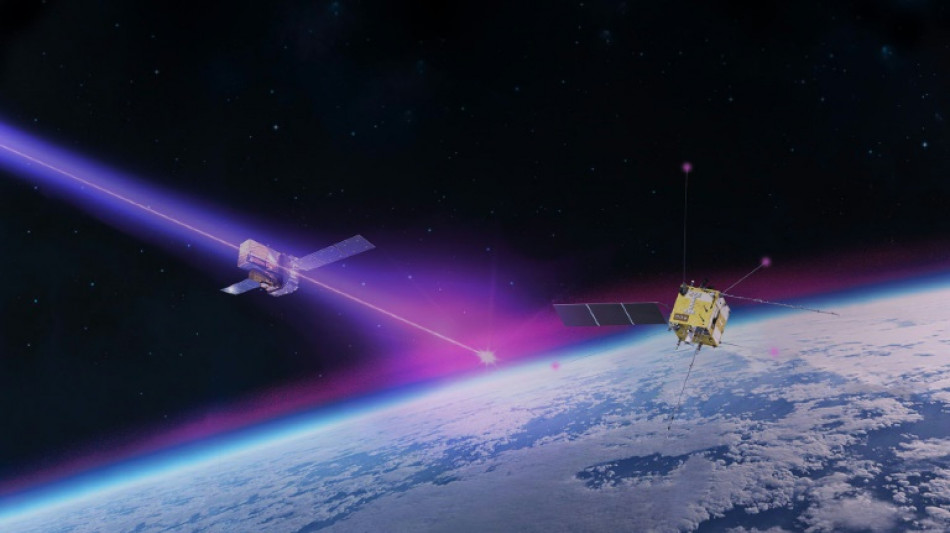
-
 Britain's storied Conservative party faces uncertain future
Britain's storied Conservative party faces uncertain future
-
New Zealand's seas warming faster than global average: report

-
 Snakebite surge as Bangladesh hit by record rains
Snakebite surge as Bangladesh hit by record rains
-
Yankees deny Blue Jays playoff sweep as Mariners beat Tigers

-
 Australia police foil 'kill team' gang hit near daycare centre
Australia police foil 'kill team' gang hit near daycare centre
-
US, Qatar, Turkey to join third day of Gaza peace talks in Egypt

-
 Gold tops $4,000 for first time as traders pile into safe haven
Gold tops $4,000 for first time as traders pile into safe haven
-
Indian garment exporters reel under US tariffs

-
 NBA back in China after six-year absence sparked by democracy tweet
NBA back in China after six-year absence sparked by democracy tweet
-
Energy storage and new materials eyed for chemistry Nobel

-
 Trump unlikely to win Nobel Peace Prize, but who will?
Trump unlikely to win Nobel Peace Prize, but who will?
-
Qatar, Turkey to join third day of Gaza peace talks in Egypt

-
 Study finds women have higher genetic risk of depression
Study finds women have higher genetic risk of depression
-
Dolly Parton's sister calls for fan prayers over health issues

-
 On Trump's orders, 200 troops from Texas arrive in Illinois
On Trump's orders, 200 troops from Texas arrive in Illinois
-
Two bodies found, two missing after Madrid building collapse

-
 Panthers raise banner as NHL three-peat bid opens with win
Panthers raise banner as NHL three-peat bid opens with win
-
Nobel physics laureate says Trump cuts will 'cripple' US research

-
 UFC star McGregor suspended 18 months over missed drug tests
UFC star McGregor suspended 18 months over missed drug tests
-
Trump talks up Canada trade deal chances with 'world-class' Carney

-
 Ecuador president unharmed after apparent gun attack on motorcade
Ecuador president unharmed after apparent gun attack on motorcade
-
Lyon exact revenge on Arsenal, Barca thrash Bayern in women's Champions League

-
 Trump says 'real chance' to end Gaza war as Israel marks attacks anniversary
Trump says 'real chance' to end Gaza war as Israel marks attacks anniversary
-
Gerrard brands failed England generation 'egotistical losers'

-
 NFL fines Cowboys owner Jones $250,000 over gesture to fans
NFL fines Cowboys owner Jones $250,000 over gesture to fans
-
Bengals sign veteran quarterback Flacco after Burrow injury

-
 New prime minister inspires little hope in protest-hit Madagascar
New prime minister inspires little hope in protest-hit Madagascar
-
Is Trump planning something big against Venezuela's Maduro?

-
 EU wants to crack down on 'conversion therapy'
EU wants to crack down on 'conversion therapy'
-
French sex offender Pelicot says man who abused ex-wife knew she was asleep

-
 Trump says 'real chance' to end Gaza war as Israel marks Oct 7 anniversary
Trump says 'real chance' to end Gaza war as Israel marks Oct 7 anniversary
-
UK prosecutors to appeal dropped 'terrorism' case against Kneecap rapper

-
 Spain, Inter Miami star Alba retiring at end of season
Spain, Inter Miami star Alba retiring at end of season
-
EU targets foreign steel to rescue struggling sector

-
 Trump talks up Canada deal chances with visiting PM
Trump talks up Canada deal chances with visiting PM
-
Knight rides her luck as England survive Bangladesh scare

-
 Pro-Gaza protests flare in UK on anniversary of Hamas attack
Pro-Gaza protests flare in UK on anniversary of Hamas attack
-
Top rugby unions warn players against joining rebel R360 competition

-
 Outcast Willis 'not overthinking' England absence despite Top 14 clean sweep
Outcast Willis 'not overthinking' England absence despite Top 14 clean sweep
-
Trump says 'real chance' of Gaza peace deal

-
 Macron urged to quit to end France political crisis
Macron urged to quit to end France political crisis
-
No.1 Scheffler seeks three-peat at World Challenge

-
 Canadian PM visits Trump in bid to ease tariffs
Canadian PM visits Trump in bid to ease tariffs
-
Stocks falter, gold shines as traders weigh political turmoil

-
 Senators accuse US attorney general of politicizing justice
Senators accuse US attorney general of politicizing justice
-
LeBron's 'decision of all decisions' a PR stunt

-
 Observing quantum weirdness in our world: Nobel physics explained
Observing quantum weirdness in our world: Nobel physics explained
-
WTO hikes 2025 trade growth outlook but tariffs to bite in 2026

-
 US Supreme Court hears challenge to 'conversion therapy' ban for minors
US Supreme Court hears challenge to 'conversion therapy' ban for minors
-
Italy's Gattuso expresses Gaza heartache ahead of World Cup qualifier with Israel


Brightest flash ever disturbed Earth's atmosphere last year
Last year the brightest flash of light ever seen in the night sky disturbed Earth's upper atmosphere in a way that has never before detected before, researchers said on Tuesday.
A massive burst of gamma rays from an enormous cosmic explosion around two billion light years away arrived at Earth on October 9, 2022, lighting up telescopes around the world.
Quickly nicknamed the "BOAT" -- for Brightest Of All Time -- the flash lasted just seven minutes but its afterglow was visible to amateur astronomers for seven hours.
The flash activated lightning detectors in India and triggered instruments that normally study explosions on the Sun called solar flares.
It also affected long wave radio communications in the lower ionosphere, a section of Earth's upper atmosphere around 60 to 350 kilometres (37 to 217 miles) above the surface.
The BOAT also affected the upper ionosphere -- the very first time a gamma-ray burst has been observed in this section of the atmosphere, a team of Italian and Chinese researchers said on Tuesday.
From 350 to 950 kilometres above Earth, near the edge of the space, the upper ionosphere is where radiation from the Sun turns into charged particles that form an important electric field.
Mirko Piersanti, a researcher at Italy's University of L'Aquila, told AFP that experts in this field had been debating for two decades whether gamma ray bursts could have any impact on the upper ionosphere.
"I think we finally answered the question," said Piersanti, the lead author of a new study in the journal Nature Communications.
The researchers were lucky that the Chinese–Italian CSES satellite, which has an electric field detector, "was exactly in the zone that was illuminated by the gamma-ray burst" 500 kilometres above Earth in the upper ionosphere, he said.
"We found a shape in the electric field that had never been observed before," Piersanti added.
"It is amazing," European Space Agency gamma-ray expert Erik Kuulkers said in a statement.
"We can see things that are happening in deep space but are also affecting Earth."
- Extinction threat? -
Piersanti said the research would help scientists understand the potential threat that other gamma-ray bursts could pose in the future.
The worst-case scenario would be if such a powerful blast came from much closer to home -- say, within our own Milky Way galaxy. That could "completely erase" Earth's ozone layer, he said.
This would expose everything on the surface to the full might of the Sun's ultraviolet radiation, potentially wiping out life on Earth.
There has previously been speculation that past gamma-ray bursts could have caused ancient mass extinction events.
But Piersanti emphasised that much remains unknown.
It is also possible that the ionosphere would absorb all the gamma rays and "nothing would happen" to those of us on the ground, he explained.
Last year's gamma-ray burst, officially called GRB 221009A, is believed to have been caused by either a massive dying star exploding into a supernova, or the birth of a black hole.
Given its immense power, it could also have been both -- a supernova explosion leading to the creation of a black hole.
The blast came from the direction of the constellation Sagitta and travelled an estimated 1.9 billion years to reach Earth.
It is now 2.4 billion light years away because of the expansion of the universe.
On average, more than one gamma-ray-burst reaches Earth every day.
But one with the brightness of the BOAT is estimated to come around once every 10,000 years.
M.Betschart--VB

